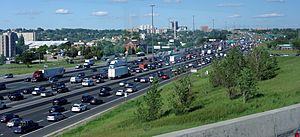Annual average daily traffic facts for kids
Annual average daily traffic, often shortened to AADT, is a special measurement used mainly in planning for roads and transportation. It tells us how busy a road or highway is. To find the AADT, engineers count all the vehicles that use a road over an entire year. Then, they divide that total number by 365 days. This gives them the average number of vehicles that use the road each day.

Annual Average Daily Traffic
AADT is a very helpful and simple way to understand how much traffic a road gets. It helps people who design roads and plan transportation systems. Knowing the AADT helps them make important decisions about road improvements, adding more lanes, or even building new roads.
Why is AADT Important?
AADT is used for many important things in transportation:
- Planning new roads: If a road has a very high AADT, it might mean that a new road or highway is needed nearby to help spread out the traffic.
- Improving existing roads: Roads with high AADT might need more lanes, better traffic lights, or stronger surfaces because they get a lot of wear and tear.
- Safety: Understanding traffic patterns can help identify dangerous spots on roads where accidents might be more likely to happen.
- Environmental studies: AADT helps estimate how much pollution vehicles might be causing in an area.
- Business planning: Businesses might look at AADT to decide where to open new stores, as more traffic often means more potential customers.
How is AADT Measured?
Traffic engineers use special tools to count vehicles. These can include:
- Traffic counters: These are often rubber tubes laid across the road or sensors buried under the surface. They count each vehicle that passes over them.
- Manual counts: Sometimes, people physically stand and count vehicles, especially for shorter periods or at specific intersections.
- Newer technologies: Modern systems use cameras, radar, or even data from GPS devices in cars to get more detailed traffic information.
Recent improvements in technology allow traffic data providers to offer even more detailed AADT information. They can now tell us the average daily traffic for each side of the road, for specific days of the week (like weekdays versus weekends), and even for different times of the day (like morning rush hour versus late at night). This detailed information helps make even better decisions about traffic flow and road management.
See also
 In Spanish: Intensidad media diaria para niños
In Spanish: Intensidad media diaria para niños


